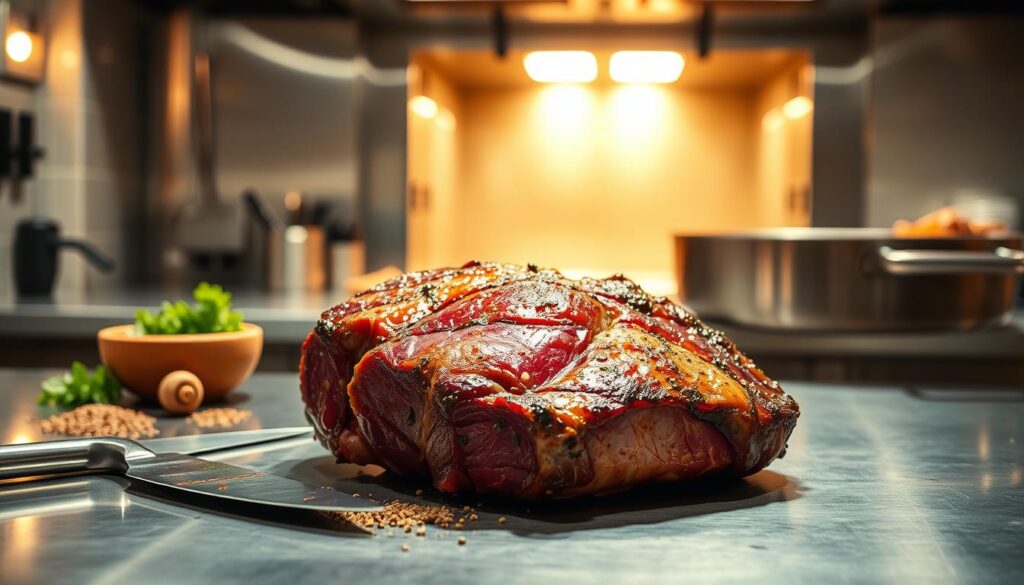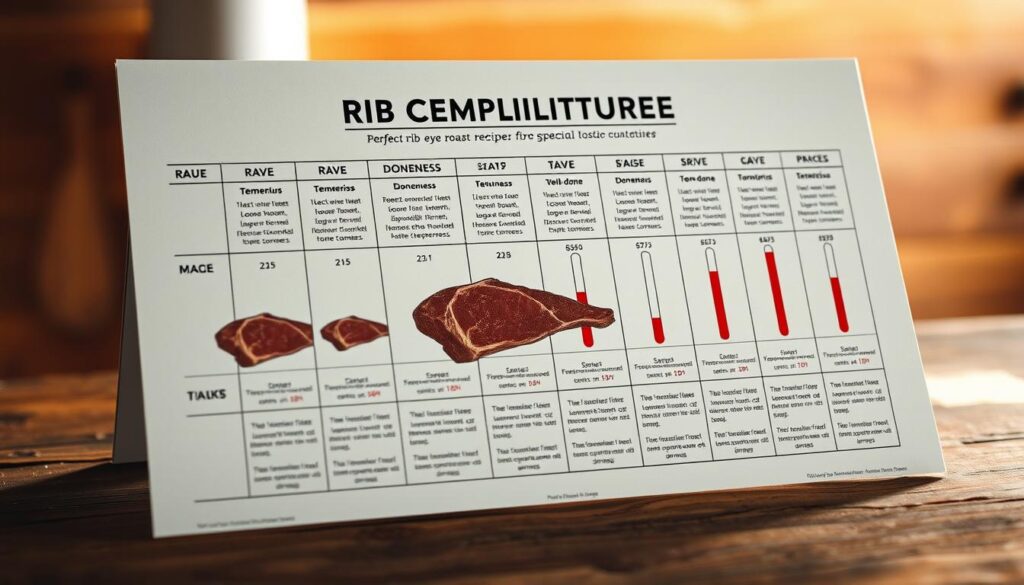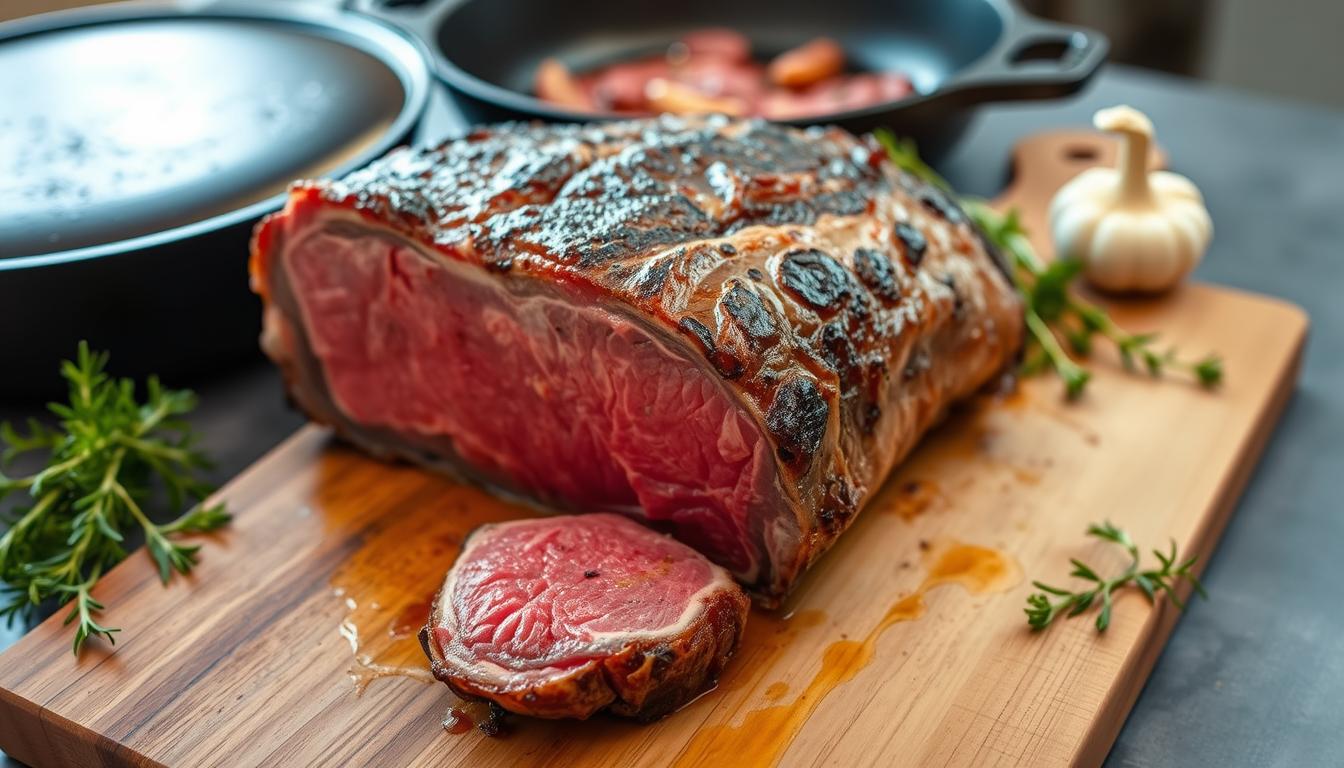Make your holiday dinner unforgettable with a stunning rib eye roast recipe. It turns a simple meal into a memorable feast. This roast beef is tender and juicy, and it’s easy to make, promising top-notch results at home.
Whether you’re having a family get-together or a fancy dinner party, a well-cooked rib eye roast will wow your guests. It’s a classic choice for holidays, offering amazing taste and soft texture. With the right steps and ingredients, you can create this impressive dish that everyone will love.
Key Takeaways
- Perfect for special occasions and holiday meals
- Requires minimal preparation time
- Serves approximately 8 people
- Yields approximately 450 calories per serving
- USDA Prime grade recommended for best results
- Easy to customize with various seasoning options
- Can be prepared ahead of time
Understanding Ribeye Roast vs. Prime Rib
Choosing the right beef roast for your special event is crucial. Knowing the difference between ribeye roast and prime rib can greatly impact your meal. These cuts may look similar, but they have unique qualities that affect how they cook and taste.
Key Differences Between Cuts
A cow has 26 ribs, and prime rib comes from ribs six to 12. The main differences are:
- Ribeye roast is boneless, while prime rib is bone-in
- Prime rib can be up to 16 pounds, perfect for big groups
- Ribeye roast is often cheaper
Choosing Between Bone-in and Boneless
Deciding between bone-in and boneless depends on several factors:
- Bone-in cuts like prime rib have a richer taste
- Boneless ribeye roast is easier to carve
- The presence of bones affects cooking time and temperature
USDA Grades Explained
Knowing about beef grades helps you pick the best prime rib or ribeye roast:
- USDA Prime: The highest quality with lots of marbling
- USDA Choice: Good marbling, slightly lower quality
- USDA Select: Least marbled, more affordable
Make the right choice to ensure a memorable meal that will wow your guests.
Essential Ingredients for the Perfect Roast
Creating a great beef dish begins with picking the right ingredients. A standout ribeye roast needs ingredients that make it special.
First, choose a top-notch ribeye roast. Opt for a USDA Prime cut with lots of marbling. It should weigh 3-4 pounds and feed about eight people. The quality of the meat affects the roast’s taste and tenderness.
Key Ingredients for Your Ribeye Roast
- Boneless ribeye roast (3-4 pounds)
- Kosher salt (1 tsp per pound of beef)
- Freshly ground black pepper (1 tsp)
- Fresh garlic cloves (3 cloves)
- Olive oil (1/4 cup)
- Fresh herbs:
- Chopped rosemary (1 Tbsp)
- Chopped thyme (1 Tbsp)
Quality ingredients are key for a great beef dish. Fresh herbs and top-notch seasonings make a simple roast unforgettable. The right mix of salt, pepper, and herbs will give your ribeye a tasty crust and boost its flavor.
Pro tip: Let your ingredients warm up to room temperature before cooking. This trick ensures your roast cooks evenly and stays juicy. Your guests will thank you for it.
Preparing Your Ribeye Roast for Cooking
To make the perfect beef roast, you need to prepare it well. Knowing the key steps will make your cooking better and your dish more delicious.
Room Temperature Essentials
It’s important to let your ribeye roast come to room temperature before cooking. Take it out of the fridge 1-2 hours before you start. This helps it cook evenly and avoids hot spots.
- Remove meat 1-2 hours before cooking
- Place on a clean surface
- Cover loosely with plastic wrap
- Keep away from direct sunlight
Seasoning Techniques
Seasoning makes a simple dish into a special meal. A good dry rub can bring out the best in your ribeye roast.
| Seasoning Component | Quantity | Purpose |
|---|---|---|
| Kosher Salt | 2 tablespoons | Primary flavor enhancer |
| Black Pepper | 1 tablespoon | Adds sharp, spicy notes |
| Garlic Powder | 1 teaspoon | Provides depth of flavor |
| Dried Thyme | 1 teaspoon | Herbal undertones |
Essential Equipment
Having the right tools is key to roasting a great beef roast. A few important pieces will make your prep work easier and more professional.
- Meat thermometer
- Roasting pan with rack
- Sharp carving knife
- Kitchen twine
- Aluminum foil
Pro tip: Always pat your ribeye roast dry with paper towels before seasoning. This helps create a perfect crust during cooking.
The Ultimate Rib Eye Roast Recipe

To make the perfect rib eye roast, you need to be precise and detailed. Start by picking a high-quality cut, about 5 pounds. This size is great for 4-6 people.
Getting ready for your roast beef is important. First, let your ribeye roast get to room temperature. Then, mix up a tasty dry rub:
- 2 tablespoons kosher salt
- 1 tablespoon brown sugar
- 2 tablespoons paprika
- 1 teaspoon black pepper
- 1 teaspoon Italian seasoning
The cooking steps for this rib eye roast recipe are crucial:
- Initial searing: 450°F for 15 minutes to lock in juices
- Slow roasting: 325°F for about 2 hours (20 minutes per pound)
Keep an eye on your roast’s internal temperature:
- Rare: 110-115°F
- Medium-rare: 120-125°F
- Well-done: 130-135°F
After cooking, let your roast beef rest for 30 minutes before carving. This step is key for juiciness and tenderness. It makes your rib eye roast truly special.
Creating the Perfect Garlic Butter Rub
Start your beef cooking journey with a special garlic butter rub. It turns a simple meat recipe into a feast for the senses. The secret is a rich, flavorful coating that gets deep into the meat.
A great garlic butter rub mixes different ingredients for a complex taste. It’s all about finding the right balance between strong and subtle flavors.
Butter to Garlic Ratio
For the best garlic butter rub, use this exact mix:
- 2 cups (1 pound) softened unsalted butter
- 2 medium heads of garlic (approximately 4 ounces)
- 1 large shallot (2 ounces), roughly chopped
Herbs and Spices Selection
Your herb mix adds depth to your beef cooking. The perfect blend includes:
- 3 tablespoons fresh rosemary
- 2 tablespoons fresh thyme
- 2 tablespoons fresh chives
- 5 anchovy fillets
- 2 tablespoons kosher salt
- 4 teaspoons freshly ground black pepper
Application Methods
When applying the garlic butter rub, be careful. Make sure the butter is soft but not melted. Rub the mixture all over the ribeye roast, making sure to cover every inch. This creates a uniform layer that will caramelize beautifully during cooking.
Pro tip: Let the rubbed roast sit at room temperature for 30-45 minutes before cooking. This helps with even heat and better flavor absorption.
Temperature Guide for Different Doneness Levels

Mastering beef cooking needs precision in internal temperatures. The doneness of your roast beef affects its taste, texture, and dining experience. Knowing the right temperature for each doneness level is key to a perfect roast.
For a ribeye roast, a meat thermometer is essential. It shows if your beef is rare, medium-rare, medium, or well-done.
| Doneness Level | Remove from Heat | Target Temperature | Appearance |
|---|---|---|---|
| Rare | 120°F (49°C) | 125°F (52°C) | Cool red center |
| Medium-Rare | 130°F (54°C) | 135°F (57°C) | Warm red center |
| Medium | 140°F (60°C) | 145°F (63°C) | Pink center |
| Medium-Well | 145°F (63°C) | 150°F (66°C) | Slight pink center |
| Well Done | 150°F+ (65°C+) | 160°F+ (71°C+) | No pink |
Here are some roast beef cooking tips:
- Always remove the roast 5-10°F below your target temperature
- Let the meat rest for 30 minutes to allow carryover cooking
- Use a high-quality digital meat thermometer for accuracy
Safety is crucial when cooking beef. Ground beef needs a 160°F internal temperature to kill bacteria. For roasts and steaks, the safe minimum is 145°F with a 3-minute rest.
Proper Resting and Slicing Techniques
Learning how to rest and slice your meat is key to a tasty beef roast. The last steps can make or break your dish.
The Importance of Resting Your Roast
Resting your beef roast after cooking is crucial. It lasts 15 to 30 minutes. During this time, the meat’s juices spread out evenly.
This makes the meat tender and juicy. It also helps with even temperature and cleaner slices.
“Patience is key when preparing a perfect beef roast. Let the meat rest and watch the magic happen.” – Professional Chef
Mastering the Slice: Cutting Against the Grain
Slicing your beef roast right is as important as cooking it well. The trick is to cut against the grain. Cutting against the grain means slicing perpendicular to the muscle fibers.
This breaks down the muscle, making the meat tender. Here’s how to do it:
- Find the direction of the muscle fibers.
- Place your knife at a 90-degree angle to these fibers.
- Make clean, uniform cuts about 1/4 to 1/2 inch thick.
By using these techniques, you’ll make your beef roast amazing. Each slice will be tender, flavorful, and beautifully presented.
Side Dishes That Complement Your Roast
Planning a perfect sunday dinner is more than just a great ribeye roast. Your holiday roast needs amazing side dishes to make the meal special. The right sides can turn a good dinner into a memorable feast.
Here are some tasty side dish options that go well with your main course:
- Mashed Potato Casserole: Loaded with crispy bacon, melted cheese, and crunchy fried onions
- Roasted Carrots: Sweetened with honey and balanced with fresh herbs
- Maple Bacon Brussels Sprouts: Combining smoky bacon with tart cranberries
- Herb Focaccia: Infused with rosemary, thyme, and sage
- Creamed Spinach: Enhanced with garlic and a touch of nutmeg
When picking side dishes for your sunday dinner, choose flavors that complement your main dish. Look for a mix of textures and tastes – creamy, crisp, sweet, and savory.
Root vegetables like carrots and parsnips are great choices. They add seasonal richness that goes well with beef. Green vegetables such as Brussels sprouts or sautéed green beans bring nutrition and color to your plate.
Pro tip: Prepare some sides in advance to reduce stress on the day of your holiday roast.
Wine Pairing Suggestions
Finding the right wine for your sunday dinner can make your holiday roast unforgettable. The right wine pairing turns your meal into a special experience. It pleases both your taste buds and your guests.
Choosing wine for a ribeye roast is about matching flavors. You want to enhance the meat’s taste without overpowering it.
Red Wine Options for Prime Perfection
Here are top red wines for your holiday roast:
- Cabernet Sauvignon: Its bold flavor and high tannins balance the meat’s richness
- Syrah/Shiraz: Offers peppery notes that boost the roast’s savory taste
- Malbec: Smooth with blackberry and plum flavors
- Red Zinfandel: Fruity with a spicy touch
Alternative Beverage Pairings
Not into wine? No problem! Here are other drinks that pair well with your sunday dinner:
- Champagne or sparkling wine: Its acidity cuts through the meat’s richness
- Craft beer with malty flavors
- Non-alcoholic options like sparkling water with citrus
The right pairing makes both the wine and the roast shine. It creates a memorable dining experience for your guests.
Storage and Leftover Tips
Handling leftover meat can be a tasty adventure, especially with a top-notch beef roast. Your ribeye roast needs the right storage to keep its great taste and quality.
Here are key tips for storing your beef roast:
- Refrigeration: Store leftover ribeye roast in an airtight container
- Maximum refrigeration time: 3-4 days
- Freezing option: Up to 3 months for optimal taste
It’s important to package your meat right. Wrap the roast in plastic wrap or foil, then in a sealed container. This keeps moisture in and prevents freezer burn.
There are many ways to use leftover beef roast:
- Steak sandwiches with horseradish sauce
- Beef tacos with fresh salsa
- Hearty beef and vegetable soup
- Steak salad with mixed greens
When you reheat, add a splash of beef broth to keep it moist. Reheat at low heat to keep the meat tender.
| Storage Method | Duration | Recommended Technique |
|---|---|---|
| Refrigerator | 3-4 days | Airtight container, wrapped tightly |
| Freezer | Up to 3 months | Vacuum-sealed or double-wrapped |
Good storage means your beef roast stays tasty and safe for many meals.
Special Occasion Serving Presentations
Turn your holiday roast into a stunning centerpiece for your Sunday dinner. A 7-10 pound standing rib roast is great for big family gatherings, serving 7-10 people. Present it on a beautiful wooden cutting board with fresh rosemary and roasted garlic for elegance.
Carve the roast with a sharp knife, slicing against the grain for tender pieces. Carve it at the table to wow your guests with the juicy inside. Choose serving platters that match the meat’s rich colors, like white porcelain or rustic ceramic.
Add seasonal touches like thyme sprigs, roasted root vegetables, or herb-infused butter to your roast. Use different heights for side dishes and garnish with fresh herbs. A well-presented Sunday dinner creates lasting memories, bringing everyone together.
FAQ
What’s the difference between a ribeye roast and prime rib?
A ribeye roast and prime rib come from the same beef cut. Prime rib is usually bone-in, while ribeye roast can be either boneless or bone-in. Both are from the rib section and known for their marbling and flavor.
How much ribeye roast should I buy per person?
Plan for ¾ to 1 pound of meat per person. This ensures everyone gets a good portion and there’s some left over. If you want more leftovers, go for 1 pound per person.
What’s the best way to achieve a perfect medium-rare roast?
Use a meat thermometer to check the roast’s internal temperature. Remove it when it hits 135°F (57°C). Let it rest for 15-20 minutes. This will raise the temperature to 140°F (60°C), making it medium-rare.
Can I prepare a ribeye roast in advance?
Yes, season the roast up to 24 hours before cooking. Store it in the fridge, covered. Bring it to room temperature for an hour before roasting for even cooking.
What’s the best way to store leftover ribeye roast?
Wrap leftover roast tightly in foil or store in an airtight container in the fridge. It lasts 3-4 days. For longer, freeze it for up to 3 months. Make sure it’s wrapped well to avoid freezer burn.
Do I need to use a special cut of beef for a ribeye roast?
While USDA Prime is best, choice grade works too. Look for meat with lots of marbling. This fat adds flavor and tenderness, making the roast more juicy and flavorful.
How long should I let the roast rest after cooking?
Let the roast rest for 15-20 minutes after taking it out of the oven. This lets the juices spread, making the meat tender and flavorful. Cover it loosely with foil to keep it warm.
What are the best side dishes to serve with a ribeye roast?
Classic sides include roasted veggies, garlic mashed potatoes, Yorkshire pudding, and roasted root veggies. Choose sides that complement the beef’s rich flavor without overpowering it.
Can I cook a ribeye roast without a meat thermometer?
It’s possible, but a meat thermometer is highly recommended. Without it, you’re guessing, which can lead to overcooked or undercooked meat. A good thermometer ensures consistent results.
What wine pairs best with a ribeye roast?
Full-bodied red wines like Cabernet Sauvignon, Bordeaux, or Syrah pair well with ribeye roast. These wines have enough structure and tannins to match the meat’s richness and intensity.

